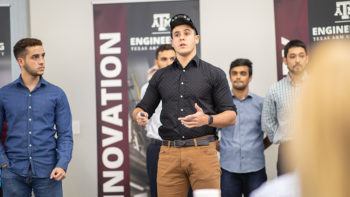Invent For The Planet Slated For Feb. 14-16

Invent for the Planet (IFTP) returns to Texas A&M University Feb. 14-16 for the third year with nearly 40 universities participating. In 48 hours, student participants around the world will collaborate to solve one of 13 global challenges.
In this two-day design competition, interdisciplinary teams of four to six students are tasked with solving issues in areas such as medical technology, education, digital security, environmental changes and transportation. The event provides an opportunity for students to network with industry professionals, meet new friends, develop presentation and problem-solving skills, and add a dynamic accomplishment to their resumé.
“Students will work locally with their peers, but also connect globally to share ideas and collaborate,” said Rodney Boehm ’78, director of the Engineering Entrepreneurship Program. “That’s where innovation happens. For one weekend, there are no barriers, there are no borders and the sun will never set on innovation.”
While two days might not seem like enough time to accomplish anything substantial, the winning teams of the previous two years continued to develop their impressive innovations beyond the competition.

Most recently, the winners of IFTP 2019, the Brazilian team Tupa from the Universidade Federal do Rio de Janeiro and the Centro Federal de Educação Tecnológica Celso Suckow da Fonseca, are fast approaching their goal of putting their innovation out into the world.
The team was inspired to design a solution that would benefit students at the Benjamin Constant Institute, a school for the visually impaired. In Brazil, they said there is a shortage of guide dogs and assistive technology for people who are visually impaired. When they entered the competition and saw a need statement about visual impairments, the team members knew this was a challenge they wanted to tackle.
Their design uses a low-profile hat with sensors and a vibrating mechanism, along with a lightweight wand that the user would move while walking. The wand would send a signal to the hat sensors, which would vibrate with increasing frequency when the user approaches an obstacle.
After participating and winning the final competition last year, they visited the Texas School for the Blind and Visually Impaired in Austin. There, they presented their idea and prototype and received invaluable feedback from professors and students.
When they returned to Brazil, they kept up their momentum. They showcased their equipment at an annual Brazilian summit that brings together hundreds of experts and personalities to discuss the political scenario and development effects in Brazil. Support for those with physical impairments, like Team Tupa’s device, fit right in with the topics of discussion. In order to learn more about their primary audience, they attended accessibility events to receive first-hand feedback and have officially partnered with the Benjamin Constant Institute.
“Thanks to the repercussions of our victory and the equipment we developed, a part of our team is going to CERN in Geneva,” said Breno Ferreira, Tupa team member. “There, we will have the opportunity to work with a similar technology for [our device’s] accelerator particle detectors, and of course we will have the space to show the winning equipment of IFTP 2019 to several scientists from around the world and improve it even more.”
Although the idea behind Invent for the Planet was developed at Texas A&M, and the event is hosted and coordinated by staff of Texas A&M, the director behind it all emphasizes that the most important aspect is lifting up the global collaboration and pursuit for solving something that impacts the world.
“Our engineering students are known for their innovation and ingenuity,” Boehm said. “This competition goes beyond that. It’s not just a good way to get students across our campus involved, but to fix something with the greatest of impacts, together.
Even though the competition is 48 hours, there is a lot of work put into the event, and it kicks off around the world at different times.
“The first event starts on Thursday afternoon our time in Vietnam. Friday afternoon is when our Aggies will come in and get the challenges,” Boehm said. “They’ll make teams, begin formulating their ideas and try to sketch out a rough prototype. Saturday is the busy day. Students work with mentors and industry to get good prototypes and begin an elevator pitch. Sunday morning, they’ll be polishing up their presentation and innovation, just in time to deliver the pitch that afternoon to judges.”
Invent for the Planet is free to enter and open to all students within any major. Boehm said that it’s not only a competition designed to take on real-world problems but also a chance to experience working together as a team.
“We open up Aggies Invent and Invent for the Planet to the whole campus for a reason,” Boehm said. “The strongest teams are interdisciplinary teams that give students a taste of what industry and real-life experience will be. I hear at each event how surprised students are to see how such a diverse team can come together and truly put together a strong and powerful solution to our global challenges.”
“IFTP was a unique life-changing experience,” Ferreira said. “We appreciate the opportunity to have participated and we strongly recommend everyone do so. Creating something that impacts society or the world in some way, even if only a little, is priceless.”
For a list of participating universities and more information, visit the Invent for the Planet website.
This article by Kristina Ballard originally appeared on the College of Engineering website.





